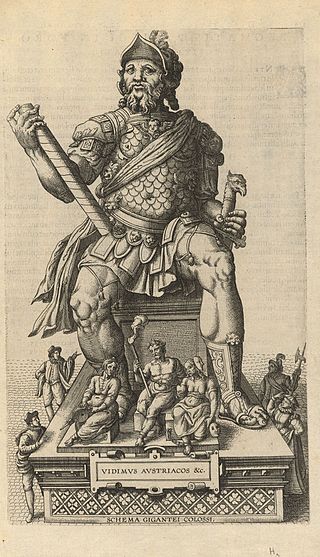Related Research Articles
The Union of Arras was an alliance between the County of Artois, the County of Hainaut and the city of Douai in the Habsburg Netherlands in early 1579 during the Eighty Years' War. Dissatisfied with the religious policies of rebel leader Prince of Orange and the States General of the Netherlands, and especially the rise of the radical Calvinist Republic of Ghent since October 1577, they signed a declaration on 6 January 1579 about their intent to offer a vigorous defense of the Roman Catholic religion against what they saw as encroachments by Calvinists in other provinces. These signatories would begin negotiations for a separate peace with the Spanish Crown, which resulted in the Treaty of Arras of 17 May 1579.

Marie de Gournay was a French writer, who wrote a novel and a number of other literary compositions, including The Equality of Men and Women and The Ladies' Grievance. She insisted that women should be educated. Gournay was also an editor and commentator of Michel de Montaigne. After Montaigne's death, Gournay edited and published his Essays.

A Joyous Entry is a ceremonial event marking the entry into a city by a monarch, prince, duke, or governor in parts of modern-day Belgium. Originating in the Middle Ages, it generally coincided with the affirmation or extension of the city's civic rights and privileges.

Maerten de Vos, Maerten de Vos the Elder or Marten de Vos was a Flemish painter. He is known mainly for his history and allegorical paintings and portraits. He was, together with the brothers Ambrosius Francken I and Frans Francken I, one of the leading history painters in the Spanish Netherlands after Frans Floris career slumped in the second half of the sixteenth century as a result of the Iconoclastic fury of the Beeldenstorm.
The following is a timeline of the history of the municipality of Antwerp, Belgium.
Events in the year 1894 in Belgium.

Philip Numan was a lawyer and humanist from the Low Countries, and a writer in prose and verse, sometimes under the pen name Hippophilus Neander.
Arnout Coninx (1548–1617) was a printer and bookseller in the city of Antwerp from 1579 until his death in 1617. In 1586 he was fined for unlicensed printing, and in 1591 he was investigated for selling forbidden books. When the city of Antwerp had been reconquered for Philip II of Spain in 1585, Protestants had been given four years to settle their affairs and leave or be reconciled to the Catholic Church. Coninx waited until 1590, after the deadline had passed, to register his conversion to Catholicism.
Jan Franco was a physician, mathematician and astronomer who compiled almanacs. He was born in the village of Eersel in the Duchy of Brabant and studied medicine at the University of Leuven. He settled in Brussels to practice medicine and was given the freedom of the city. He was a practicing physician at least until 1594. As he had studied both medicine and mathematics, he was asked to calculate the ephemerides, for purposes of medical astrology. This led to his work as a compiler of almanacs from 1586 to 1611. From 1612 to 1621 Arnout Coninx and his widow were selling almanacs based on Franco's drafts but completed for publication by his son, Jan Franco jr., and by Johannes Regius. At least as late as 1616 almanacs prepared by others were being sold on the strength of their association with Franco.
Events from the 1580s in the Spanish Netherlands and Prince-bishopric of Liège.
Events from the 1590s in the Spanish Netherlands and Prince-bishopric of Liège.

Joannes Bochius, sometimes Jan Boghe or Jean Boch (1555–1609) was a civic officeholder and Neo-Latin poet in the city of Antwerp.

Johannes Lievens, Latinized Johannes Livineius (1546/47–1599), was a scholar of Greek patristics from the Habsburg Netherlands.
The following lists events that happened during 1907 in the Kingdom of Belgium.
Events in the year 1873 in Belgium.
Frédéric Perrenot (1536–1600), lord of Champagney, baron of Renaix, was a soldier and diplomat in Habsburg service.
Events in the year 1877 in Belgium.
Michel d'Esne de Betencourt (1540–1614) was a prelate in the Habsburg Netherlands.
Louis Hymans (1829—1884) was a Belgian writer, lecturer and politician.
References
- J. Roulez, "De Meyere (Leon)", Biographie Nationale de Belgique , vol. 5 (Brussels, 1876), 561–563.